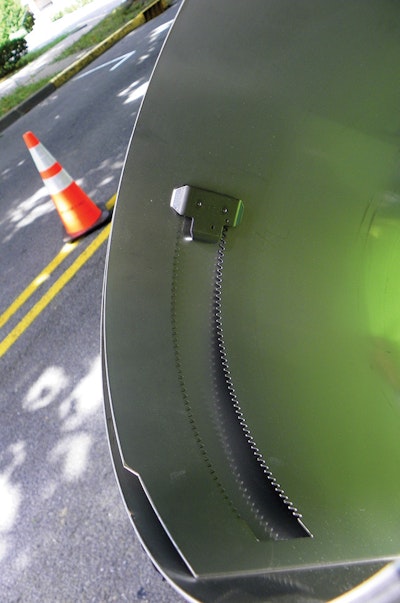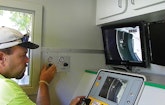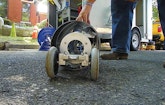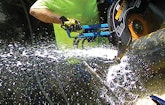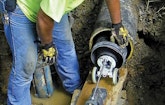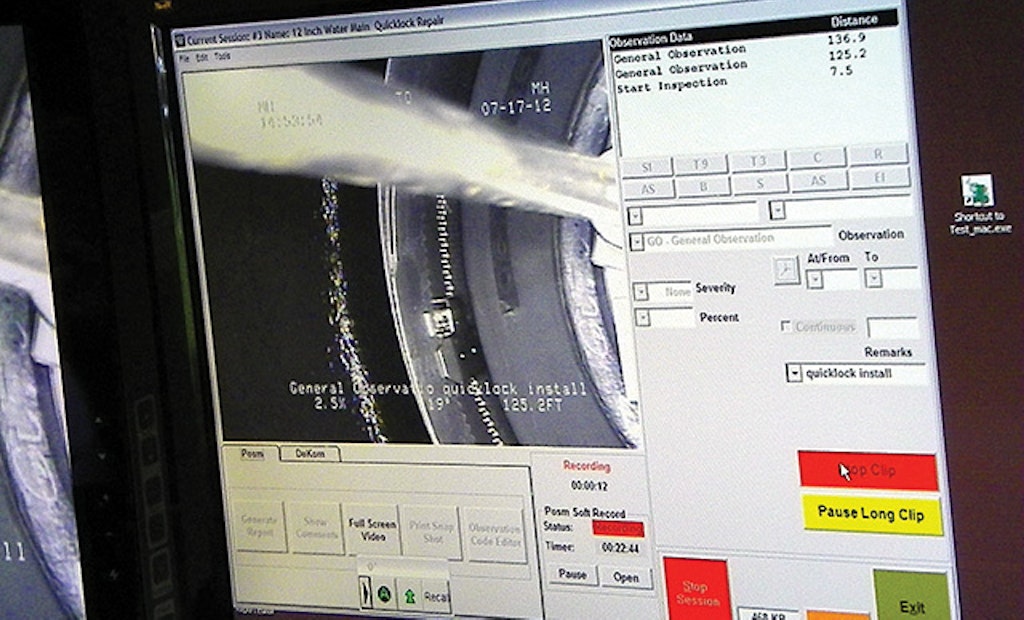
Interested in Rehab/Relining?
Get Rehab/Relining articles, news and videos right in your inbox! Sign up now.
Rehab/Relining + Get AlertsRepairing the joints in larger diameter iron or steel pipes of a potable water supply system has never been an easy process. The traditional approach of digging up and replacing each lead-sealed bell joint one at a time is expensive and time consuming, not to mention disruptive to traffic and customers. Restoring street surfaces every 10 to 13 feet adds tremendous non-pipe repair-related costs to these projects.
The Rausch USA QuickLock point repair system eliminates most of the excavating and resurfacing costs by sealing these joints from inside the distribution pipe. Performing joint work from inside the pipe allows the infrastructure owner to avoid most of the hassles typically associated with these jobs. The Rausch Electronics USA inside-the-pipe repair or maintenance technology is approved by the U.S. EPA for potable water systems. This repair process was also approved by the Pennsylvania Department of Environmental Protection.
This technology was observed in the course of a scheduled job on a hot July day in the Borough of Bellefonte, Pa. The Borough's public works crew's assignment was to replace every joint in a 600-foot section of a 50-year-old, 12-inch-diameter, ductile iron waterline under one of the borough's busiest streets. Bellefonte is located about 10 miles from State College — home of Penn State University — and is the first municipality in the Commonwealth to implement this technology.
Crew members included Ron Pletcher, Dave Kleinfelter, Greg Brown and Brett Meyer. During the work, borough manager Ralph Stewart and William Comly Jr., the public works superintendent, stopped by to see the system in operation. Rausch president Rudy Ellgass, marketing coordinator Josh Frankenfield and national product consultant Jeff Rager were on site to both observe and, if necessary, offer instruction.
Walk around
There are three components to the QuickLock system that are used in conjunction with a Rausch tractor and its related control system, a CCTV camera, the associated data and image recording systems and an appropriate deployment platform.
The packer is an expandable rubber cylinder mounted on four wheels. The wheels are sized to carry the cylinder roughly in the horizontal centerline of the pipe being serviced. When a sleeve is positioned on the packer, the bladder is expanded sufficiently to hold it during transport to the joint being repaired. The packer is the first component of the work train to enter the pipe.
An 18-inch-long hollow twist-lock connected pushrod joins the packer to the pushing tractor. The hollow pushrod allows compressed air to be introduced into or withdrawn from the cylinder. At the tractor's forward end, the pushrod snaps onto a fitting. This fitting is on the forward end of an air supply tube that has a conventional male quick-disconnect compressed air fitting. It is through this fitting, which is positioned near the back of the tractor, that the long hose from an air compressor is secured to the work train.
The final component is the expandable two-piece stainless steel sleeve assembly that is carried into the pipe. Shipped in two parts, an unbroken EPDM rubber seal and the V4A stainless steel sleeve it will slide into must be joined before deployment. Once in place at a joint site, the packer's bladder and the sleeve and its EPDM seal are expanded. The seal has raised ridges at either end that are compressed to conform to the receiving pipe's irregularities. The sleeve's internal cam lock system secures it into place. Once a sleeve is positioned at a joint site, the packer is deflated and withdrawn along with the tractor, completing the repair.
In addition to joint repair, the sleeve also isolates the lead seals associated with bell style joints. If linear cracks are encountered, multiple sleeves can be placed. In this application, each subsequent sleeve overlaps the prior sleeve by about an inch.
Additional support components were required to successfully deploy and position each seal. These included a Rausch Series M tractor fitted with a KS135 pan-and-tilt camera. Rausch's preferred POSM inspection software controlled the tractor's movements and displayed the camera's imagery.
All of this was mounted in the borough's deployment platform, a custom outfitted 12-foot (l) by 6-foot (w) by 6 1/2-foot (h) utility trailer. The onboard ELKA 600 cable reel's capacity of 1,000 feet of control cable is the only limit to the distance this system can reach. An air hose of equal length is the only addition necessary to make an inspection camera support platform joint-repair ready. In Bellefonte's case, the hose was carried, deployed and recovered on a manually operated hose reel.
Operation
Work on this project started the day before the actual repair when a rough 12- by 8-foot pit was dug around the water pipe. The excavation bottom was about 2 feet below the bottom of the pipe to accommodate the workers, work platform and the hydraulically powered circular saw that was used to sever the pipe. Before closing isolation valves at either end of the segment, appropriate work zone traffic control measures were re-established. Because this is a borough-owned street, no street-cut permit was needed. When breached, the pipe's roughly 2,400 gallons of isolated water filled the pit. The pit was drained by a pair of trash pumps with the discharges directed to a nearby storm drain.
A 5-foot section of pipe was removed and a temporary work platform using a 2 x 12 plank and several cinder blocks was placed in the breach. With the plank's surface and the pipe bottom at nearly the same elevations, the process of introduction and retrieval of the work train was simplified.
Rausch recommends a camera inspection before placing the first sleeve. This inspection revealed unexpected debris that had to be flushed by partially opening the upstream valve. There was no way to know the debris situation prior to breaching the pipe. When the debris was cleared, the location of each joint was noted and a quick condition assessment was completed.
The first sleeve was introduced and pushed into place at the farthest joint. This process was controlled from the deployment trailer using standard Rausch POSM controls. The operator positioned the sleeve so that half was on either side of the joint. Using manually operated valves mounted in the control cabin, the bladder on the packer was expanded until the self-locking cam locks inside the sleeve were fully expanded and securely locked. Close inspection using the camera verified the installation.
The train was retrieved and the next joint was sealed. The process was repeated until all the joints were sealed. Soon, the crew was working at a pace of one joint every 13 minutes. The workflow is always from the farthest point to the point of entry. When the work was completed in the upstream segment, the process was repeated in the downstream segment. Careful selection of the entry point enabled the entire run between valves to be addressed from a single breach point.
Because the job could not be completed in single day, it was necessary for the borough to restore water service to the affected customers. This was done using a precut length of pipe held in place using a Dresser coupling. This process is essentially a long-term repair solution which, in this case, was used first to restore water overnight and then reinstalled, permanently, when all of the joints accessible from this breach were addressed. When all joints were restored and the permanent patch was in place, the crew and deployment vehicle were free to begin setup at the next site.
Equipment used to repair potable water systems must be dedicated to those tasks as disinfection of the tractor, camera, packer and associated hose and cable would be challenging. Even with dedicated equipment, the crew regularly sprayed down the equipment with a chlorine solution between deployments.
Observer's comments
The joint-sealing process is neither complex nor physically challenging. Site preparation and restoration are more challenging since nearby buried infrastructure must be identified and protected.
A practiced crew like that at Bellefonte develops a rhythm. All crew members worked each task. This cross-training is foresighted as it leaves all crew members fully skilled in every task.
The packer/pushrod is an easy add-on to most manufacturers' tractor/CCTV systems. It requires no task-specific software and only slight modifications to install the bladder control valves at the operator's station in the deployment vehicle.
Owner's comments
"This repair process is working out well for the borough. From a single road cut we can handle many joints. We figure each road cut costs about $4,000 including road restoration costs, but there is a lot more benefit than a dollar savings. We inconvenience fewer residents and leave most of the road intact," said Ron Pletcher, assistant public works superintendent.
"Every time we do these repairs, we get better. The old way we were lucky to repair a single joint in a day when you consider excavation, repair and restoration tasks. We can repair joints and isolate lead solder. Our customers win," says Dave Kleinfelter, head of the Water Department.
Manufacturer's comments
"Worldwide, there are over 100,000 sleeves in use in both sewer and water pipes. Bellefonte expressed an interest in the QuickLock product and process to solve leak and lead isolation challenges in their water distribution system. We appreciate the borough's pioneering spirit being on the cutting edge of this technology," says Rudy Ellgass.
